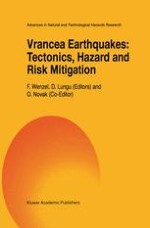
1999 | OriginalPaper | Buchkapitel
Modern Recording of Seismic Strong Motion for Hazard Reduction
verfasst von : Bruce A. Bolt
Erschienen in: Vrancea Earthquakes: Tectonics, Hazard and Risk Mitigation
Verlag: Springer Netherlands
Enthalten in: Professional Book Archive
Aktivieren Sie unsere intelligente Suche, um passende Fachinhalte oder Patente zu finden.
Wählen Sie Textabschnitte aus um mit Künstlicher Intelligenz passenden Patente zu finden. powered by
Markieren Sie Textabschnitte, um KI-gestützt weitere passende Inhalte zu finden. powered by
Striking progress has occurred in recording strong shaking from damaging earthquakes since the 4 March 1977 Vrancea, Romania, earthquake (Mw = 7.4). Free-field accelerometers in seismic regions have significantly increased in number, geographical distribution, and dynamic range. Many digital instruments are now operational. In Europe and the Middle East alone, the number of individual triaxial recordings during the last 30 years exceeds 2500. Of particular importance, the 1989 Loma Prieta, 1992 Landers, 1994 Northridge (all in California), and the 1995 Hyogo-ken Nanbu, (Kobe) Japan, earthquakes have provided not only hundreds of key free-field accelerograms but many instrumental records of building response.In Romania there are now over 70 strong motion accelerometer stations and an important data base of seismic ground motion records is accumulating, including records from the intermediate depth Vrancea earthquakes of 1977, 1986, and 1990. The Bucharest accelerograms of the 1977 earthquake are of the greatest value in predicting future strong ground motions in Bucharest. The 1 to 2 sec velocity pulse in the horizontal components (repeated in the 1986 earthquake) is generated by directivity focussing of energy from the moving source rupture at intermediate depth (about 80 to 120 km) towards Bucharest. The thick alluvial layer under the city further amplifies the 1 to 2 sec S wave energy. The 1977 Bucharest record may, therefore, be taken as “characteristic” of the maximum input design motions in Bucharest.Attenuation laws for hazard analysis of intra- and interplate crustal earthquakes in many seismic regions have recently improved. In the near field, the dominant velocity pulse (or “fling”) from the radiation mechanism and directivity for strike-slip and thrust sources has been found to differ significantly between fault-normal and fault-parallel azimuths. Also, reflections from deep crustal structure can contribute to the seismic wave strong motions. Unfortunately for ground motion estimation in Romania, near-source recordings from intermediate depth sources and Mw > 7.0 earthquakes around the world remain sparse. To obtain a comprehensive distribution of recordings for hazard estimation in Romania, many more digital instruments are needed in different geological conditions and at various azimuths.Forensic earthquake engineering to understand structural vulnerability depends on correlation between ground motion records near to engineered structures (particularly from near-structure reference stations) and recorded motions of the structure. As well, digital recording systems can now provide near-real-time warnings and intensity maps, time histories, and spectral variations over the shaken region. All high seismic hazard regions need such digital recording systems, linked to absolute time through inexpensive GPS satellite telemetry.